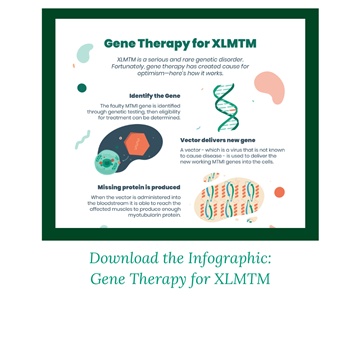X-linked myotubular myopathy, otherwise known as XLMTM, is a rare genetic disorder that primarily causes muscle weakness. The protein myotubularin—which is essential for our ability to breathe and swallow—is either missing or severely reduced due to a mutation to the MTM1 gene. The disease is severe and often leads to premature infantile death. Fortunately, there is opportunity for gene therapy to improve the lives of those with XLMTM.
Gene Therapy Approach
 Patients suffering from XLMTM do not have enough of the myotubularin protein, so the body may require a ventilator to support breathing and a feeding tube for nourishment. Since gene therapy is the first candidate for XLMTM, it is an exciting advancement for the community. This approach aims to achieve a one-time treatment via IV or injection through administration of a vector (carrier) that delivers functional MTM1 genes to do the work that wasn't being done before. The goal is to increase production of myotubularin protein allowing our muscles to contract and, in turn, giving patients the ability to breathe and swallow on their own. The treatment is not a cure for the disease, but a means to control disease progression and reduce symptoms.
Patients suffering from XLMTM do not have enough of the myotubularin protein, so the body may require a ventilator to support breathing and a feeding tube for nourishment. Since gene therapy is the first candidate for XLMTM, it is an exciting advancement for the community. This approach aims to achieve a one-time treatment via IV or injection through administration of a vector (carrier) that delivers functional MTM1 genes to do the work that wasn't being done before. The goal is to increase production of myotubularin protein allowing our muscles to contract and, in turn, giving patients the ability to breathe and swallow on their own. The treatment is not a cure for the disease, but a means to control disease progression and reduce symptoms.
Treatment Pipeline
There are gene therapy approaches for XLMTM that are currently in preclinical studies and clinical trials. Research and development in clinical trials is being done by Astellas Gene Therapies (formerly Audentes) and there are other companies with XLMTM treatments in the preclinical study phase, which involves understanding the therapy in animals and cell-based models before they are ready for human clinical trials.
To stay up to date on active and recruiting clinical trials in the U.S. or globally, visit the ASGCT Clinical Trials Finder.
Pathway to Treatment
Diagnosis
First, the disease needs to be detected. The symptoms of XLMTM typically show up at birth and can be described as “floppy” because of low muscle tone. Diagnostic measures can include the evaluation of the family’s health history and specialized testing. Typically, XLMTM is confirmed once the mutations in the MTM1 gene is detected. This disease almost exclusively appears in males since “X-linked” means that the mutation is in a gene on the X chromosome. However, female carriers can sometimes show symptoms of muscle weakness, usually in later adulthood. Genetic testing may be an option before or during pregnancy to determine if the child is at risk for MTM.
Eligibility
You may be wondering how patients can participate in clinical trials for therapies like AT132. Participating in these trials is a way to receive an investigational treatment at no cost, while also benefiting the medical community and others who have the disease. If an individual is interested in a clinical trial, it is best to first speak with your primary care physician to learn more. Then, the individual must meet eligibility criteria, which can be based on age at the time of dosing, physical ability or medical treatment history.
Age Limitations
Currently, patients need to be under the age of five to be eligible for AT132 treatment in clinical trials. Why is that? Well, age is a key variable for how a patient’s body operates. For example, with an older patient, the disease may have had more time to do damage in the body. A younger patient may still be able to see results where the disease’s effects are slowed or stopped. Basically, an age limitation allows the researcher to better understand dosing and results of the therapy. Down the road, as the treatment moves through the phases of development and if it eventually gets approved, the next goal would be to expand the treatment to reach more patients by spanning various ages and classifications of the disease.
AAV Vectors
The vector used to deliver the new working gene is called an adeno-associated virus (AAV). This virus is not known to cause disease, but has the ability to get inside cells it needs to deliver genetic material.
While using AAV vectors, it is important that a patient doesn’t have antibodies that can counteract the virus. This is a challenge because patients may already be immune to the virus even before they receive the treatment. This is result is uncontrollable and comes from previous infection of the naturally occurring AAV in our environment. Also, chemotherapy or medication might be necessary to prevent the body’s own natural immune response from blocking any benefit of the therapy.
Access
At this time, we do not know if or when this gene therapy will be approved by the FDA (or the EMA for therapies in Europe) and commercially available to more patients. The therapy candidate furthest along is in the early phases of clinical trial and the overall process can take several years to ensure that the treatment is safe and effective.
Patient and Family Support
Patient advocacy organizations work hard to raise awareness, advocate and fund research. They also provide support, advice, and information for getting involved and are a great way to connect with other families affected by MTM. Although the disease may be rare, you are not alone.
For more information, visit: